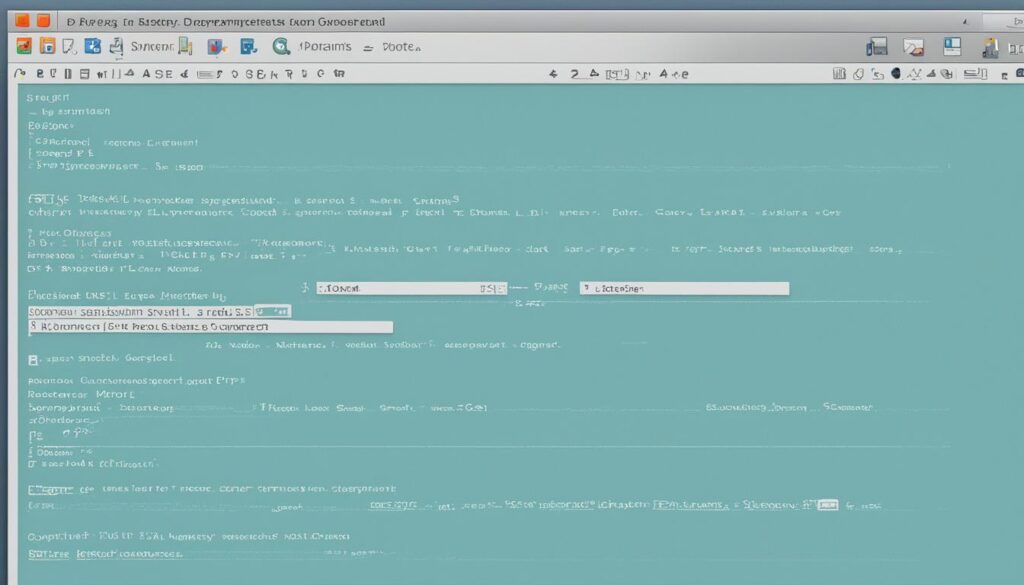Have you ever wondered how modern web applications achieve real-time, bidirectional communication? The answer lies in the power of Python WebSockets. In this comprehensive guide, I’ll take you on a journey to explore the fascinating world of WebSockets and how they can revolutionize the way you build responsive, engaging, and efficient web applications.
But wait, there’s a burning question that I need you to ponder: What if I told you that the traditional HTTP protocol is no longer enough to meet the demands of today’s dynamic web applications? The truth is, the world of web development is evolving, and WebSockets are the key to unlocking the next generation of real-time, interactive experiences. Join me as we dive into the world of Python WebSockets and uncover the secrets to creating cutting-edge applications that can keep up with the pace of modern user expectations.
Introduction to WebSockets
In the dynamic world of modern web applications, the need for real-time communication has become increasingly crucial. Traditional HTTP protocols, with their request-response model, often fall short in delivering the seamless and instant data exchange that many applications require. This is where WebSockets come into play, revolutionizing the way client-server interactions are handled.
Understanding Real-Time Communication
Real-time communication is a fundamental aspect of WebSockets. Unlike the traditional HTTP protocol, which relies on a series of independent requests and responses, WebSockets establish a persistent, bidirectional data transfer channel between the client and the server. This allows for instant, real-time updates, enabling applications to push information to users without the need for constant polling or refreshing.
The Need for Bidirectional Data Transfer
In many applications, the ability to transfer data in both directions is essential. WebSockets address this need by providing a full-duplex communication channel, where both the client and the server can initiate and respond to messages. This bidirectional data transfer capability is particularly beneficial for applications that require instant updates, such as chat systems, online games, and collaborative tools, where the exchange of information must be immediate and seamless.
By leveraging the power of real-time communication and bidirectional data transfer, WebSockets enable the development of highly interactive and responsive web applications that thrive on event-driven architecture and efficient message passing.
What are Python WebSockets?
Python WebSockets are a powerful set of libraries and tools that enable you to implement real-time, bidirectional communication in your Python applications. These libraries abstract the complexities of the WebSocket protocol, allowing you to focus on building your application’s core functionality rather than dealing with the underlying network protocols.
Python’s robust asynchronous programming capabilities make it an excellent choice for developing event-driven, real-time applications using python websockets. With the help of these libraries, you can create highly responsive and interactive applications that can handle multiple clients simultaneously, enabling features like chat applications, collaborative editing, and more.
At the heart of python websockets lies the concept of asynchronous programming. This programming paradigm allows your application to handle multiple tasks concurrently, without getting stuck waiting for a specific operation to complete. This is particularly useful in socket programming, where you need to manage multiple client connections and respond to events efficiently.
| Feature | Description |
|---|---|
| Real-time Communication | WebSockets enable instant, two-way communication between the client and the server, allowing for seamless data exchange in real-time. |
| Asynchronous Handling | Python’s asynchronous programming capabilities make it easy to manage multiple WebSocket connections and handle events efficiently. |
| Reduced Overhead | WebSockets have a smaller overhead compared to traditional HTTP-based communication, making them more efficient for real-time applications. |
By leveraging python websockets, you can build a wide range of real-time applications, from chat systems and online games to collaborative tools and IoT solutions. These libraries provide a seamless way to integrate WebSocket-based communication into your Python projects, empowering you to create highly interactive and responsive applications that deliver an enhanced user experience.
The WebSocket Protocol
The WebSocket protocol, standardized as RFC 6455, provides a standardized way for a client and server to establish a persistent, two-way communication channel. Unlike the traditional HTTP request-response model, WebSockets allow for immediate, real-time data exchange in both directions. This bidirectional data transfer offers several advantages, such as reduced latency, more efficient data transfer, and the ability to build more responsive and interactive web applications.
How WebSockets Differ from HTTP
The primary difference between WebSockets and HTTP is the way they handle communication. HTTP is a request-response protocol, where the client initiates a connection, sends a request, and the server responds. In contrast, WebSockets establish a persistent, two-way communication channel, allowing both the client and server to send data at any time without the need for a new connection.
Advantages of WebSocket Communication
- Real-time real-time communication: WebSockets enable immediate, bidirectional data exchange, reducing latency and allowing for more responsive applications.
- Efficient data transfer: WebSockets require less overhead compared to traditional HTTP requests, resulting in more efficient data transfer and reduced network load.
- Reduced server load: WebSockets maintain a persistent connection, eliminating the need for repeated client-server handshakes, which can decrease server load.
- Improved user experience: The seamless, real-time nature of WebSocket communication can enhance the overall user experience, particularly in applications that require instant updates or real-time collaboration.
| Feature | HTTP | WebSockets |
|---|---|---|
| Communication model | Request-response | Bidirectional, persistent |
| Latency | Higher | Lower |
| Data transfer efficiency | Lower | Higher |
| Server load | Higher | Lower |
| User experience | Less responsive | More responsive |
By understanding the key differences between WebSockets and HTTP, developers can make informed decisions about the most appropriate protocol for their real-time communication needs.

python websockets: The Key to Real-Time Applications
When it comes to building real-time, event-driven applications, Python WebSockets are a game-changer. By leveraging the power of the WebSocket protocol, developers can create applications that provide immediate updates, seamless interactions, and a more responsive user experience. Whether you’re building a chat application, a collaborative editing tool, or a real-time dashboard, Python WebSockets can help you deliver the level of interactivity and immediacy that modern users expect.
At the heart of Python WebSockets is the concept of event-driven architecture. Unlike traditional client-server models where the client must constantly poll the server for updates, WebSockets enable a true two-way communication channel. This allows for message passing between the client and server, ensuring that updates are pushed to the client as soon as they occur, without the need for constant polling.
This real-time, event-driven approach is particularly well-suited for applications that require immediate feedback, such as:
- Live chat and messaging applications
- Collaborative editing tools
- Real-time data visualizations and dashboards
- Multiplayer online games
- IoT (Internet of Things) monitoring and control systems
By leveraging Python WebSockets, developers can create these types of real-time applications that provide a seamless and responsive user experience, without the limitations of traditional HTTP-based communication.
Asynchronous Programming with WebSockets
When it comes to building real-time applications, Python’s WebSockets shine brightly. By leveraging the power of asynchronous programming, you can create efficient, scalable, and responsive applications that can handle multiple concurrent connections and real-time data exchanges. This approach is particularly well-suited for network programming, where the ability to handle asynchronous events is crucial.
Event-Driven Architecture
At the heart of this asynchronous approach lies the event-driven architecture. With WebSockets, your application can respond to various events, such as incoming connections, data received, or connection closures, without getting bogged down in a synchronous, blocking flow. This event-driven model allows your application to remain agile and reactive, processing messages as they arrive, and seamlessly managing multiple client-server interactions.
Python’s powerful asynchronous capabilities, enabled by libraries like asyncio, make it an excellent choice for building WebSocket-based applications. By embracing an event-driven architecture, you can create applications that are efficient, scalable, and responsive, capable of handling the demands of asynchronous programming, message passing, and network programming.
The combination of WebSockets and asynchronous programming opens up a world of possibilities for developers seeking to build event-driven architecture solutions. Whether you’re creating real-time chat applications, collaborative editing tools, or other network-centric applications, this powerful approach can help you deliver exceptional user experiences and overcome the limitations of traditional synchronous communication models.
WebSocket Libraries in Python
When it comes to working with python websockets in Python, developers have access to a variety of robust libraries and frameworks. These WebSocket libraries abstract the low-level details of the WebSocket protocol, allowing you to focus on the core functionality and logic of your application. Let’s explore some of the popular options available.
One widely used library is WebSocket-client, which provides a simple and straightforward API for interacting with WebSocket servers. It supports both synchronous and asynchronous programming models, making it a versatile choice for a wide range of network programming projects.
Another popular option is aiohttp, a comprehensive web framework that includes built-in support for WebSockets. Designed for socket programming in an asynchronous environment, aiohttp offers a seamless integration with other Python libraries and frameworks, making it a great choice for building scalable real-time applications.
For those looking for a more lightweight and focused WebSocket solution, Tornado is a compelling choice. This event-driven networking library excels at handling WebSocket connections, providing a simple and efficient way to implement bidirectional data transfer between clients and servers.
When selecting a WebSocket library for your Python project, consider factors such as performance requirements, integration with other frameworks, and the specific needs of your application. By leveraging these powerful tools, you can unlock the full potential of real-time communication and build innovative, responsive, and engaging applications.

Socket Programming in Python
At the core of WebSocket communication are socket APIs, which provide the fundamental building blocks for network programming in Python. While you can build WebSocket-based applications using low-level socket APIs, it’s generally more practical to use high-level WebSocket libraries that abstract the complexity of the protocol and provide a more developer-friendly interface.
Low-Level Socket APIs
Low-level socket APIs, such as the built-in socket module in Python, offer a direct interface to the underlying TCP/IP protocol. These APIs enable you to create, connect, and manage sockets, allowing you to control the entire communication process. However, using low-level socket APIs can be challenging, as you’ll need to handle tasks like handshaking, message framing, and other WebSocket-specific tasks.
High-Level WebSocket Libraries
To simplify the development process, many Python developers opt for high-level WebSocket libraries, such as websocket-client, aiohttp, or gevent-websocket. These libraries abstract the complexity of the WebSocket protocol, providing a more intuitive and developer-friendly interface. They handle the handshaking process, message framing, and other WebSocket-specific tasks, allowing you to focus on your application’s logic.
| Library | Description | Key Features |
|---|---|---|
| websocket-client | A WebSocket client implementation for Python, compatible with both Python 2 and 3. |
|
| aiohttp | An asynchronous HTTP client/server framework for Python, with built-in WebSocket support. |
|
| gevent-websocket | A WebSocket library for the gevent networking library in Python. |
|
By using these high-level WebSocket libraries, you can focus on developing your application’s functionality, rather than getting bogged down in the low-level details of the WebSocket protocol. This allows for more efficient and streamlined network programming in Python.
Message Passing with WebSockets
WebSockets are a game-changer when it comes to efficient message passing between clients and servers. Unlike traditional HTTP, WebSockets enable real-time communication and an event-driven architecture that is crucial for building modern, network programming-powered applications.
With WebSockets, you can send data in both directions instantly, without the need for polling or long-running HTTP requests. This message passing model is particularly useful for applications that require immediate updates, such as chat apps, collaborative tools, and real-time dashboards.
WebSockets facilitate a seamless flow of information, allowing your application to respond to events and user actions in real-time. This event-driven architecture enables you to build more engaging and responsive user experiences, where the server can push updates to the client as soon as they occur, rather than the client having to constantly check for changes.
By leveraging the power of message passing through WebSockets, you can create highly interactive and network programming-driven applications that provide users with the instant feedback and updates they expect in today’s fast-paced digital landscape.
| Feature | Benefits |
|---|---|
| Instant Message Passing | Enables real-time communication and immediate updates |
| Bidirectional Data Transfer | Allows for seamless information flow between client and server |
| Event-Driven Architecture | Facilitates responsive and engaging user experiences |
By harnessing the power of message passing with WebSockets, you can create innovative, real-time communication-driven applications that truly engage and delight your users. Unlock the full potential of event-driven architecture and network programming with Python WebSockets.
Network Programming with WebSockets
In the realm of network programming, WebSockets have emerged as a powerful tool for building scalable web applications. By leveraging the event-driven architecture and asynchronous programming capabilities of WebSockets, developers can create applications that efficiently manage and respond to real-time data updates, making them well-suited for a variety of use cases, from real-time dashboards to online games and collaborative tools.
One of the key advantages of using WebSockets for network programming is the ability to handle a large number of concurrent connections. Unlike traditional HTTP-based communication, where each request and response require a new connection, WebSockets establish a persistent, bidirectional channel between the client and server. This persistent connection allows for the seamless exchange of data, reducing the overhead associated with establishing and maintaining multiple connections.
Harnessing Asynchronous Programming for Scalable Solutions
WebSockets are designed to operate in an asynchronous manner, which means they can handle multiple tasks concurrently without blocking the main execution thread. This event-driven architecture allows WebSocket-based applications to respond to real-time updates and events efficiently, making them highly scalable and capable of handling a large number of concurrent users or clients.
By embracing asynchronous programming and event-driven architectures, developers can create network programming solutions that are able to process and respond to scalable web applications in near real-time, without the need for constant polling or expensive server resources. This efficient communication model is particularly beneficial for applications that require immediate, bidirectional data exchange, such as chat applications, collaborative editing tools, and real-time monitoring dashboards.
| Feature | Benefit |
|---|---|
| Asynchronous programming | Enables efficient handling of multiple tasks concurrently without blocking the main execution thread |
| Event-driven architecture | Allows applications to respond to real-time updates and events in a scalable manner |
| Persistent, bidirectional communication | Reduces the overhead associated with establishing and maintaining multiple connections, enabling network programming for scalable web applications |

By harnessing the power of WebSockets, developers can create network programming solutions that are both scalable and responsive, able to handle a large number of concurrent users or clients while delivering a seamless, real-time experience. This makes WebSockets an invaluable tool for building the next generation of scalable web applications that thrive on event-driven architecture and asynchronous programming.
Real-World Use Cases
The power of Python WebSockets shines through in their diverse real-world applications. One notable use case is in the realm of chat applications, where WebSockets enable seamless real-time communication between users. With their ability to provide instant, bidirectional data exchange, WebSockets ensure that messages are delivered promptly, and users can receive updates on the presence and activities of their peers in real-time.
Another area where WebSockets excel is in collaborative editing tools. These applications allow multiple users to simultaneously view and edit the same document, with changes propagating instantaneously across all connected clients. This real-time synchronization empowers teams to work together effectively, fostering productivity and efficient collaboration.
Chat Applications
In the world of chat applications, WebSockets shine by providing a reliable and efficient communication channel. Their real-time nature ensures that messages are delivered instantly, creating a seamless and engaging user experience. WebSockets also enable features like presence updates, allowing users to see when their peers are online and active, further enhancing the overall communication experience.
Collaborative Editing
WebSockets also play a crucial role in collaborative editing tools, where multiple users can work on the same document simultaneously. With WebSockets, changes made by one user are instantly reflected on the screens of all other connected users, enabling real-time collaboration and reducing the risk of conflicts or data loss. This functionality is particularly valuable in scenarios where team members need to work together on projects, reports, or other shared documents.
| Use Case | WebSocket Benefits |
|---|---|
| Chat Applications | Real-time messaging, presence updates |
| Collaborative Editing | Simultaneous document editing, real-time synchronization |
Best Practices for WebSocket Development
As a professional copywriting journalist, I understand the importance of following best practices when developing WebSocket-powered applications. To ensure the security, performance, and scalability of your WebSocket solutions, there are several key considerations to keep in mind.
First and foremost, prioritizing WebSocket security is crucial. Establish secure WebSocket connections by implementing robust authentication and authorization mechanisms, encrypting data in transit, and regularly auditing your application’s security posture. Proper error handling and reconnection logic are also essential to maintaining the integrity of your WebSocket communication.
Optimizing WebSocket performance is another critical aspect of best practices. Minimize latency and maximize throughput by carefully managing WebSocket lifecycle events, optimizing message payloads, and implementing efficient message routing and dispatching mechanisms. Leveraging asynchronous programming models and event-driven architectures can help you achieve exceptional WebSocket performance.
Finally, ensuring WebSocket scalability is key to building applications that can handle increasing user demand and data volumes. Employ load-balancing strategies, leverage distributed architectures, and optimize resource utilization to ensure your WebSocket-based applications can scale seamlessly as your user base grows.
By embracing these best practices, you can develop robust, secure, and high-performing WebSocket-powered applications that deliver an exceptional real-time user experience. Remember, attention to detail and a holistic approach to WebSocket development are the keys to success.
| Best Practice | Description |
|---|---|
| Secure WebSocket Connections | Implement robust authentication, authorization, and data encryption mechanisms to ensure the security of your WebSocket communication. |
| Efficient Error Handling and Reconnection | Develop reliable error handling and reconnection logic to maintain the integrity of your WebSocket-based applications. |
| Optimized WebSocket Performance | Minimize latency and maximize throughput by carefully managing WebSocket lifecycle events and optimizing message handling. |
| Scalable WebSocket Architecture | Employ load-balancing strategies and distributed architectures to ensure your WebSocket-powered applications can scale effectively. |
Conclusion
As I reflect on the power of Python WebSockets, I’m truly amazed by their ability to transform the way we build real-time, interactive web applications. By understanding the WebSocket protocol and leveraging Python’s asynchronous programming capabilities, developers like myself can create engaging, responsive, and efficient applications that deliver instant updates and seamless interactions to our users.
Whether I’m building a chat app, a collaborative tool, or a real-time dashboard, Python WebSockets have become a crucial part of my development arsenal. The bidirectional data transfer and event-driven architecture that WebSockets provide allow me to create applications that feel alive and responsive, providing my users with the kind of experience they expect in today’s digital landscape.
As I continue to explore the vast potential of Python WebSockets, I’m excited to see how the technology will evolve and the new use cases that will emerge. From improving the user experience of web applications to enhancing the performance and security of real-time communication, the key benefits of Python WebSockets are undeniable. I’m confident that as I master this powerful tool, I’ll be able to create innovative, cutting-edge web applications that truly make a difference for my clients and users.
FAQ
What are Python WebSockets?
Python WebSockets are a set of libraries and tools that allow you to implement WebSocket-based communication in your Python applications. These libraries abstract the complexities of the WebSocket protocol, enabling you to focus on building your application’s logic rather than dealing with the underlying network protocols.
How do WebSockets differ from traditional HTTP?
Unlike traditional HTTP, which relies on a request-response model, WebSockets provide a persistent, two-way connection, allowing for immediate and seamless data exchange. This is particularly useful for applications that require instant updates, such as chat applications, online games, and collaborative tools.
What are the advantages of using WebSockets for real-time communication?
WebSockets offer several advantages, such as reduced latency, more efficient data transfer, and the ability to build more responsive and interactive web applications. The bidirectional communication enabled by WebSockets allows for immediate, real-time data exchange in both directions, which is crucial for building real-time, event-driven applications.
How does asynchronous programming benefit WebSocket-based applications?
WebSockets are particularly well-suited for asynchronous programming, which is a fundamental aspect of modern network programming. Python’s powerful asynchronous capabilities, enabled by libraries like asyncio, make it an excellent choice for building WebSocket-based applications. By using an event-driven architecture, you can create efficient, scalable, and responsive applications that can handle multiple concurrent connections and real-time data exchanges.
What are some popular Python WebSocket libraries?
Python offers several robust libraries and frameworks for working with WebSockets, including WebSocket-client, aiohttp, and Tornado. These libraries abstract the low-level details of the WebSocket protocol, allowing you to focus on your application’s logic and functionality. The choice of library depends on factors such as performance requirements, integration with other frameworks, and the specific needs of your application.
How do WebSockets enable efficient message passing?
WebSockets enable efficient message passing between clients and servers, facilitating real-time communication and event-driven architectures. By using WebSockets, you can send data in both directions instantly, without the need for polling or long-running HTTP requests. This message passing model is particularly useful for building applications that require immediate updates, such as chat apps, collaborative tools, and real-time dashboards.
What are some common real-world use cases for WebSockets?
WebSockets find numerous applications in the real world, particularly in scenarios that require instant, bidirectional data exchange. One common use case is building chat applications, where WebSockets enable seamless real-time messaging and presence updates. Another example is collaborative editing tools, where WebSockets allow multiple users to simultaneously view and edit the same document, with changes propagating in real-time.
What are the best practices for WebSocket development?
Developing successful WebSocket-based applications requires following certain best practices, such as ensuring secure WebSocket connections, implementing proper error handling and reconnection logic, optimizing for performance and scalability, and properly managing WebSocket lifecycle events. By adhering to these best practices, you can build robust, secure, and efficient WebSocket-powered applications that deliver an exceptional user experience.












